Author: Heechang, Dan Elitzer
Translator: Block unicorn
In 2022, Dan Elitzer (the founder of IDEO Futures, an industry veteran) wrote that Unichain (Uniswap's L2 chain) is inevitable, as he believed it would stem from the inefficiencies and value leakage in the existing Uniswap system. He pointed out that current Uniswap traders face three types of costs: the swap fees paid to liquidity providers, the transaction fees paid to Ethereum validators, and the MEV (Miner Extractable Value) costs.
Now, this prediction has become a reality, as the most widely used decentralized cryptocurrency trading protocol, Uniswap, has announced the launch of its dedicated Layer 2 solution, called Unichain. This OP Stack-based Rollup aims to address key challenges in the DeFi ecosystem, focusing on improving the trading execution environment, enhancing the user experience, and solving the problem of liquidity fragmentation.
1. Background - The Logic Behind Unichain
1.1 Dan Elitzer's Prediction
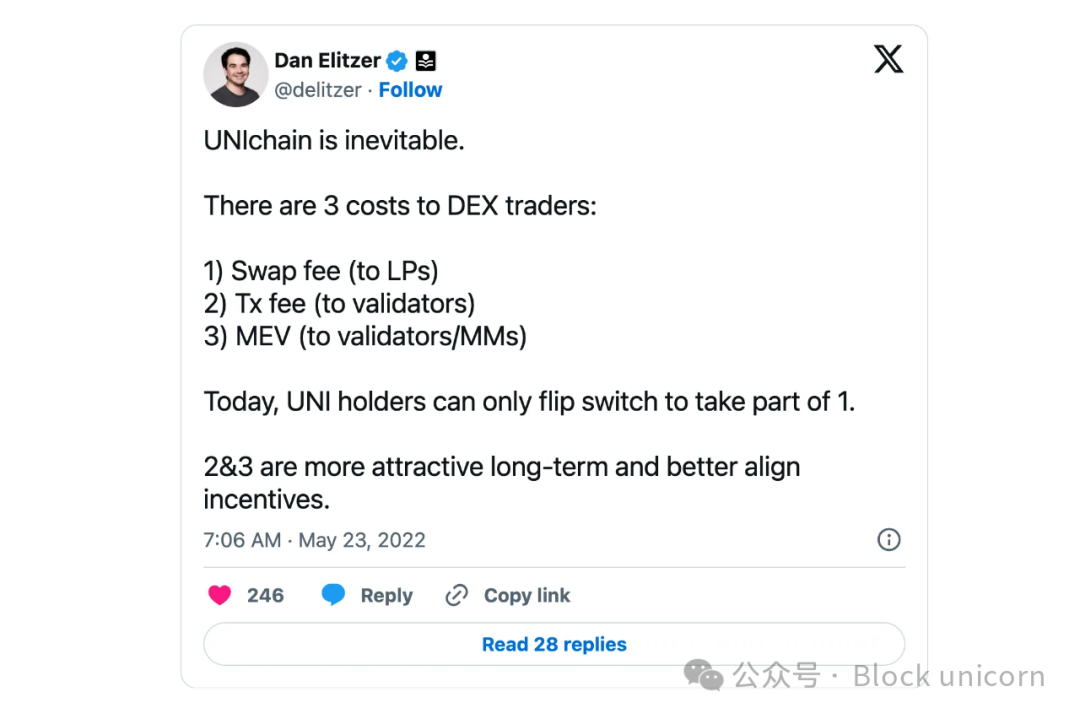
Dan Elitzer's research showed that the transaction fees paid to Ethereum validators and market makers, as well as the MEV costs, exceeded the swap fees earned by liquidity providers. This means that entities outside of Uniswap are in a more advantageous position in terms of value capture, and the value that should have belonged to Uniswap users, liquidity providers, or $UNI token holders is being extracted externally.
Block unicorn's note: MEV refers to Miner Extractable Value, where opportunistic traders can bribe miners to prioritize their transactions, front-running our trades and profiting from the arbitrage opportunities, thereby increasing the cost of our on-chain transactions.
In summary, the argument for the necessity of Unichain: Unichain can help reduce the problem of value capture inefficiency caused by transaction fees and MEV costs, and increase the value for $UNI holders. By operating its own chain, Uniswap can significantly reduce transaction fees, especially beneficial for small transactions. Additionally, solutions like range encryption or batch swaps can reduce traders' MEV costs.
The biggest advantage of Unichain is that it can achieve a better incentive mechanism among Uniswap participants. Currently, $UNI token holders have limited choices in value capture, mainly limited to governance decisions, such as adjusting swap fees. The dedicated chain will allow $UNI holders to benefit from transaction fees and internalized MEV, enhancing the value proposition of the token. This approach not only rewards $UNI holders but also creates a more efficient trading platform for users, potentially consolidating Uniswap's position as the leading decentralized exchange (DEX).
1.2 Unichain - Capturing More Value and Achieving Unification
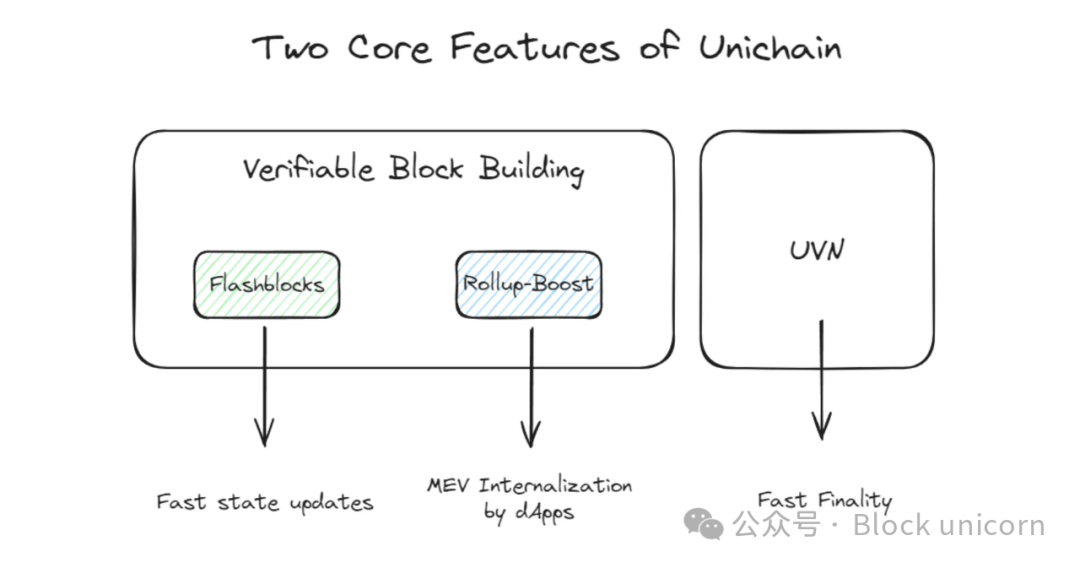
As a super-chain built on the OP Stack, Unichain brings two innovations aimed at improving cross-L2 blockchain efficiency, user experience, and liquidity management:
The first key feature is Verifiable Block Building, developed in collaboration with Flashbots, including a mechanism called Flashblocks. It achieves an effective block time of 200-250 milliseconds by dividing each block into four sub-blocks. This system allows Unichain to update its state more quickly. Additionally, Unichain uses a Trusted Execution Environment (TEE) to separate the sequencer and block builders, and implements Priority Ordering, which taxes MEV opportunities, allowing applications to directly extract and internalize MEV.
The second major feature is the Unichain Verification Network (UVN), a decentralized network of node operators that independently verify the blockchain state. UVN allows Unichain to provide fast finality and settle cross-chain transactions through economic security. When new blocks are generated on Unichain, the validators must prove that they are part of the canonical chain, reducing the security risks posed by a single sequencer. To become a validator, one must stake $UNI, and if selected as part of the active node set based on the staking weight, they will perform the verification and receive corresponding rewards. This operating model allows $UNI holders to delegate their stake to validator nodes and receive a share of the rewards.
2. Key Points - The Direction of DeFi Development Proposed by UniChain
Decentralized Finance (DeFi) is no longer limited to a single application, but has chosen an increasingly complex development path. DeFi applications are actively internalizing the value they generate, operating their own application chains or Layer 2s, and developing wallet services. Application-Specific Sequencing (ASS), which allows applications to directly extract MEV, is also gaining attention. Among these trends, the launch of Unichain clearly demonstrates the future direction of DeFi development: DeFi with sufficient user base and scale will ensure the independence of its own infrastructure.
2.1 DeFi is Becoming "Fatter"
DeFi is choosing to internalize the value that would otherwise be extracted externally, improve the user experience, or provide self-contained "money legos" through the interoperability of their own financial products, through a more complex development process.
This trend is manifested in applications that do not adopt Layer 2 or Layer 3 execution methods, using ASS design to avoid exposure to MEV extraction in the transaction ordering process. For example, by controlling the order of transactions dependent on external oracle data, applications can directly capture MEV (i.e., Oracle Extractable Value, OEV), or avoid MEV exposure through the use of a solver network-based intent-based batch auction. Alternatively, they are enhancing the user experience and preventing value leakage to external third-party infrastructure by developing auxiliary infrastructure, such as optimized application wallet infrastructure or mobile interfaces.
2.1.1 ASS (Application-Specific Sequencing): CoW AMM
CoW AMM protects liquidity providers (LPs) from the impact of MEV by batching transactions offline and auctioning the arbitrage portion. In CoW AMM, whenever there is an arbitrage opportunity, solvers will compete for the right to rebalance the CoW AMM pool. The solver who offers the most favorable trading conditions and retains the most profit (surplus) in the liquidity pool will be granted the right to rebalance the pool. Through this batch auction, CoW AMM can capture the MEV value that arbitrage bots would have extracted when rebalancing the liquidity pool, and eliminate the LVR (Loss versus Rebalance) risk faced by LPs.
2.1.2 Mobile / Wallet: Jupiter / Uniswap Wallet
Looking at the current market share of user devices, mobile devices account for 63%, while desktop devices account for 37%, indicating a significant growth in the mobile usage environment. Therefore, establishing a mobile environment has become more important in the development of crypto applications.
Recently, Jupiter has launched a mobile app that can handle all functions, from swapping, slippage adjustment, priority fee adjustment to fiat on-ramps, in a mobile environment. Users can trade at the best prices without fees by routing through Jupiter, providing a better DeFi experience.
Additionally, Uniswap has also developed and deployed its own wallet service. Through this wallet, users can conveniently swap from Uniswap's liquidity pools at the routed trading price, while Uniswap Labs charges a frontend fee on the swaps made through the wallet, creating a sustainable cash flow.
This shows that DeFi is no longer limited to the implementation of decentralized exchanges (DEXs), money markets, or options DeFi contracts, but is achieving increasingly complex DeFi through the introduction of ASS or the development of additional infrastructure. In this way, applications maximize the internalization of value to redistribute it to participants or provide enhanced application experiences. However, Unichain's choice of its own Layer 2, aiming to become the "home of DeFi and cross-chain liquidity", indicates that for DeFi to create greater potential, expansion to Layer 2 is an important choice beyond single applications.
2.2 From Dapps to Layer 2
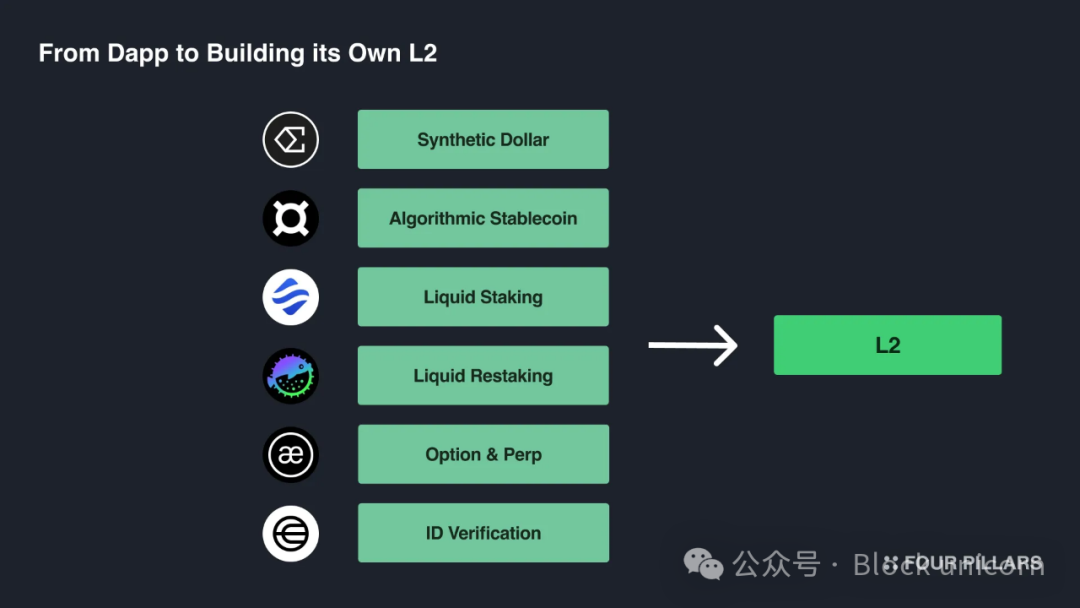
With the launch of Unichain, the roadmap for applications to expand to Layer 2 has become clearer. Many applications have already chosen to improve their infrastructure and user experience by expanding to Layer 2, starting from a single DeFi product (such as stablecoins or liquid staking) and gradually expanding their vision. This Layer 2 transformation can create significant value for applications in two main aspects: 1. Improved user experience and reduced costs: By moving to Layer 2, applications can significantly reduce gas fees and improve transaction speed and reliability, providing a better user experience. 2. Capturing more value: On Layer 2, applications can internalize more of the value they generate, such as transaction fees and MEV, and distribute it to their participants (e.g., through staking rewards) or reinvest it to improve the application. This trend is not limited to Ethereum-based applications, as we see similar developments on other Layer 1 blockchains like Solana, TRON, and Kin. These applications are also exploring ways to build their own Layer 2 solutions or integrate with existing ones to enhance their infrastructure and capture more value. In summary, the launch of Unichain demonstrates that the future of DeFi lies in the ability of applications to build their own dedicated infrastructure, whether it's Layer 2 or other specialized chains. This allows them to optimize the user experience, internalize the value they generate, and create a more sustainable ecosystem for their participants.
First, based on the L2 infrastructure, applications can create various values through unique mechanisms. For example, block space sales based on block demand have long been proven to be a profitable business in the crypto industry, while the revenue of sequencers and MEV extraction have created significant cash flow for L2 operators. Unichain's L2 architecture proposes new possibilities for operating MEV in a differentiated manner through priority ordering. Unichain separates block builders and sequencers through TEE, allowing applications to directly control MEV and operate the obtained MEV in the case of an agreement with users. In other words, Unichain provides a platform environment where MEV is controlled by applications and users, rather than sequencers, and operates under consistent rules. This provides a meaningful methodology for L2 of specific applications to adopt this mechanism to control MEV.
Another value that can be enhanced by applications transforming to L2 is from the perspective of token economics. The $UNI token of Uniswap has long had limited demand, with almost no use cases other than governance functions. Therefore, the Fee Switch plan was previously proposed, which aimed to distribute Uniswap's revenue to $UNI holders, but due to regulatory concerns, this proposal was not actively promoted.
In this context, the launch of Unichain has given $UNI a practical use case. To become a validator of the UVN, $UNI must be staked to build cryptoeconomic security, and $UNI holders can obtain allocated rewards by delegating their stake to validator nodes. Therefore, the transformation of applications to L2 creates the possibility of value accumulation for the native token, covering various ways from sequencer revenue to MEV and staking rewards.
While the L2 transformation can significantly enhance value in these two aspects, is it the ideal development direction for the Ethereum ecosystem? Like all solutions, it brings double-edged results. From the perspective of the entire Ethereum ecosystem, there are currently more than 100 different L2s that are decentralizing the liquidity on the Ethereum mainnet. Furthermore, relatively less value is being accumulated on the Ethereum mainnet compared to L2 activities, leading to a "parasitic" problem of L2s on the Ethereum economy.
2.3 Ethereum Value Accumulation Problem
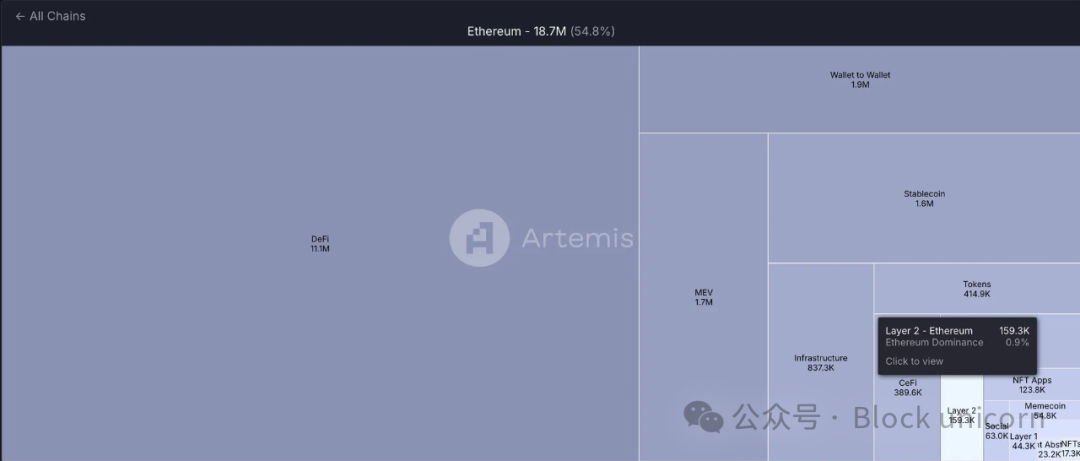
The system of Ethereum currently obtaining value from L2 solutions has problems. As more and more applications build their own L2s, these problems become more apparent. Currently, L2s only use about 0.9% of Ethereum's total gas fees, indicating a disconnect between L2 growth and mainnet value appreciation. Recent updates, such as EIP-4844, further reduce the fees L2s pay to Ethereum, which may decrease the demand for ETH as gas fees.
This situation has raised concerns about L2s potentially "parasitizing" Ethereum economically. Although Ethereum has a large ecosystem and a strong developer community, its economic model is being questioned. As the fees paid by L2s decrease, it means a reduction in Ethereum network's revenue, which may weaken the value of ETH. I believe that while L2 solutions benefit from Ethereum's existing system, they may not be supporting the economic health of the mainlayer sufficiently.
However, as the L2 ecosystem expands, it may attract more liquidity, potentially establishing ETH as the primary currency for economic activity within Ethereum. While this may maintain the use of ETH as an asset, the question remains: Can ETH continue to grow and become a more valuable asset in such a system?
3. Other Perspectives
3.1 Jon Charboneau's Perspective: "L2 is to Ethereum as Tesla is to California."

3.2 Mason Nystrom's Perspective from Pantera
Key insights on Unichain and its significance:
Token Value Capture: $UNI has evolved from a governance token to a fee-accruing token. Validators with the highest $UNI stake earn rewards by validating the network and collecting fees.
Unichain Supports "Fat App" Thesis: Applications are creating their own chains to achieve economic control and block space management. Uniswap's chain will capture fees from various transactions, including swaps, lending, and perpetuals, beyond traditional DEX activities.
Internalizing MEV: Unichain's verifiable block building and "flash block" ordering demonstrate potential. Applications are exploring how to internalize MEV or redistribute it to users and stakeholders.
Unichain and Ethereum: Unichain may have a significant impact on the Ethereum mainnet. DeFi activity may shift to Unichain, with the appeal being the sequencer fees from $UNI staking and better user pricing.
Vertical Integration: Larger applications have the incentive to control the entire tech stack - from the application (Uniswap wallet, frontend + Uniswap X) and protocols (Uniswap V4, V3, V2) to the blockchain (Unichain).
These perspectives highlight the potential impact of Unichain on the DeFi ecosystem, particularly in terms of token economics, MEV internalization, and the trend of applications controlling the chain.
3.3 Ryan Watkins' Perspective from Syncracy Capital
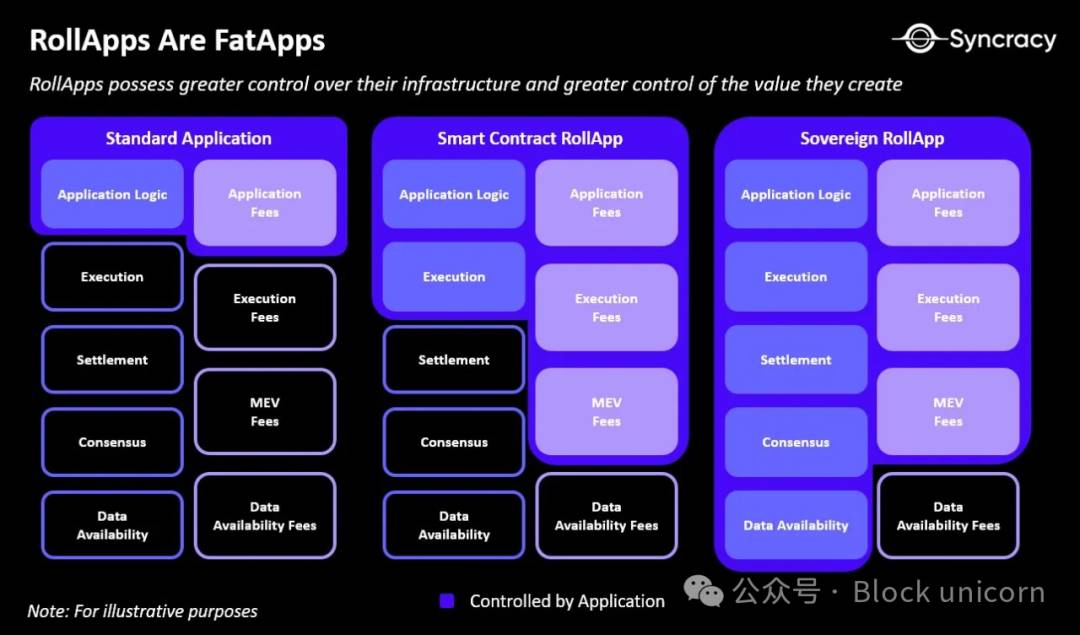
In this article, Ryan Watkins questions the view that Bitcoin and stablecoins are the only valuable blockchain applications. He believes we have entered an era of blockchain application diversification. Platforms like Ethereum and Solana now host many revenue-generating and fast-growing applications. However, the valuations of these applications still lag behind their underlying blockchain infrastructure. Trends indicate that applications are earning an increasing share of blockchain fees, often exceeding the value of the infrastructure assets. This shift may mark a turning point in blockchain development.
The rise of "fat apps" in blockchain represents an increase in application autonomy. Drivers for the "fat app" development include the need for better scalability, improved user experience, and greater economic control relative to the underlying infrastructure. As chain abstraction and smart wallet technologies evolve, this application-centric approach is expected to become more seamless, potentially reshaping the distribution of value and control within the blockchain ecosystem.
Ryan Watkins' perspective emphasizes the growing importance of applications in the blockchain ecosystem and the impact of this trend on the distribution of value and control between infrastructure and applications.







